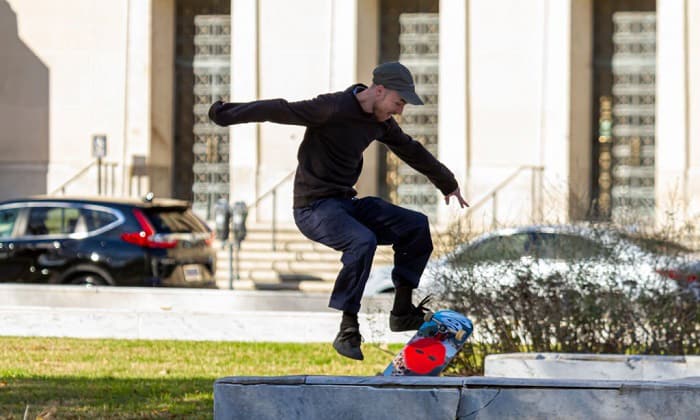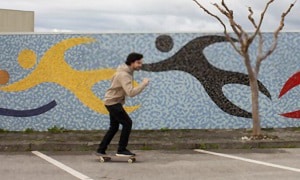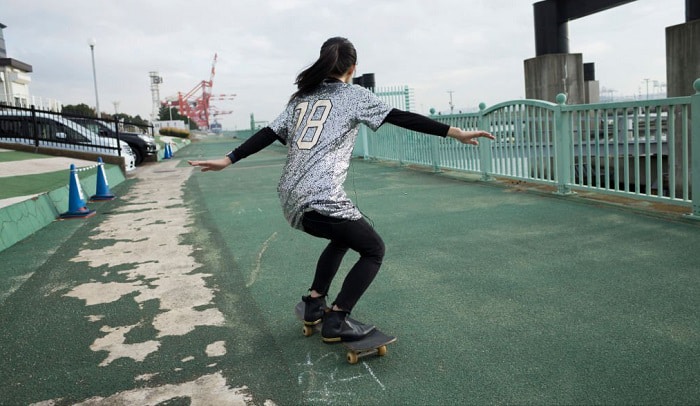If you have been skating for years, you have probably mastered how to fall correctly on a skateboard. But if you are a beginner or an intermediate skater, you tend to focus more on avoiding tumbles.
True enough, why do we always have to anticipate bad landings on skateboards when we can prevent them? So, how to not fall off a skateboard? It’s time to learn the best practices to keep you from meeting accidents with your boards.
Table of Contents
What to Prepare
- Safety gear – Safety equipment does not prevent a skateboard fall. But it will protect you once you slip off your deck accidentally, such as helmet, knee pads, wrist guards,…
- A good skateboard – Sometimes, skateboards that do not suit our style and preference cause bad falls. So, ensure you have a decent skateboard with quality trucks, decks, and wheels.
Tips to Not Fall on a Skateboard
Before you can fall properly on a skateboard, you’ll need enough courage to practice tumbling in the first place. If you’re not ready to do that yet, here’s what we can do to avoid a fall off a longboard.
1. Warming up
One of the causes of a disruptive skateboard fall is stiff muscles. When these tissues are tight, we can’t seem to maximize our body movements. So, what can we do about it? Stretch.
Start by working on your neck with a few rotations. Next, stretch your shoulders and arms. Work on your hips by giving them a good bend. Finally, loosen the muscles on your calves and roll your ankles to achieve flexibility.
After warming up your body, try to push the skateboard around in an open space. You don’t need to do elaborate tricks, just exert enough effort to stretch your body to the fullest extent.
Additionally, warming up before skateboarding can reduce fatigue by improving oxygen and blood flow throughout the body.
2. Skate safely
Whether you plan to ride a skateboard in parks or downhill, there will always be a threat to your safety. Consider the following measures.
- Skate in a safe space
The first thing we should assess when choosing a skating spot is if it’s manageable. We don’t need to go to a skate park when we don’t even know how to glide on a ramp.
Similarly, when we decide to take on the streets, we should ensure that the space is free from debris. In both of these situations, let’s try to avoid crowds or many skaters riding around.
So, where is the best spot to skate? It could be an empty parking lot or your yard (if it’s big and level enough).
- Manage your speed
Skateboarding is not necessarily about pushing hard and moving fast. If you don’t feel confident skating quickly, don’t try downhill rides yet. Increasing your speed is a gradual process. So, the best way is to practice in increments.
- Be mindful of the weather
Unlike cars, skateboards have less immunity against wet roads. So, before heading to the skate park to meet your friends, always check the weather forecast. And if the dark sky tells you not to go, don’t create any risk.
3. Always start with the basics
Aside from increasing your speed gradually, you should also learn the fundamentals of the sport. If the trick calls for you to balance on a skateboard, then do it. No skater ever started as a professional.
For example, you can work on simple carving or basic ollies. And once you feel confident doing these skills, you can finally try on new ones.
Essentially, another benefit of mastering the basics is we get better at riding a skateboard.
How Do You Push a Skateboard Without Falling?
Pushing is a fundamental way to keep momentum on a skateboard. Here’s how to prevent falling off while moving your board.
- Step 1: Find your dominant foot and achieve a natural stance.
- Step 2: Place your front or dominant foot on the deck above the front truck bolts. It should be at around a 45° angle.
- Step 3: Bend your front and back knee slightly.
- Step 4: Lean your body forward.
- Step 5: Perform a pushing motion with your back foot against the ground.
- Step 6: Place your rear foot on the deck behind the front foot, and spread your arms to help your body balance.
- Step 7: Once the skateboard gains momentum, position your body and feet perpendicular to the deck.
- Step 8: Repeat the 5th step once the skateboard slows down, and follow with the succeeding steps.
Be mindful of the steps before and after pushing the skateboard. These will help you achieve a stable stance when doing the skill.
What to Do After Falling Off a Skateboard?
So, it happened. You fell off the skateboard and are unsure what happened to you. Here’s what professionals and skaters on Reddit recommend you do.
- Perform an initial assessment of the type of injury or damage you have.
- Seek medical help to cure bruises and fractures. Doing so will also help you identify unseen injuries in case you fell off skateboard and hit head.
- Identify the causes of injuries. In the case of accidents caused by moving vehicles, seek legal actions that may apply.
Conclusion
Skateboarding should always be safe. And while accidents are inevitable, that doesn’t mean we can’t reduce them.
So, if you slip off your skateboard, don’t give up, because everyone goes through it. What you can do is learn how to not fall off a skateboard.
We can begin working on our foundations and improving our skills gradually. Then, we can reduce the risks of injuries and enjoy skating better.
Be mindful of the tips we shared to guide you to safety and help you once these skateboarding mishaps happen.

Hi, I am Charles Harris. I opened this site to write as much as I can about my biggest passion – skateboarding!
I started as a clumsy yet passionate rookie 10 years ago to now a still passionate yet much better skateboarder! But I have to tell you, the whole journey has always been fun and rewarding, indeed not without hardship.





